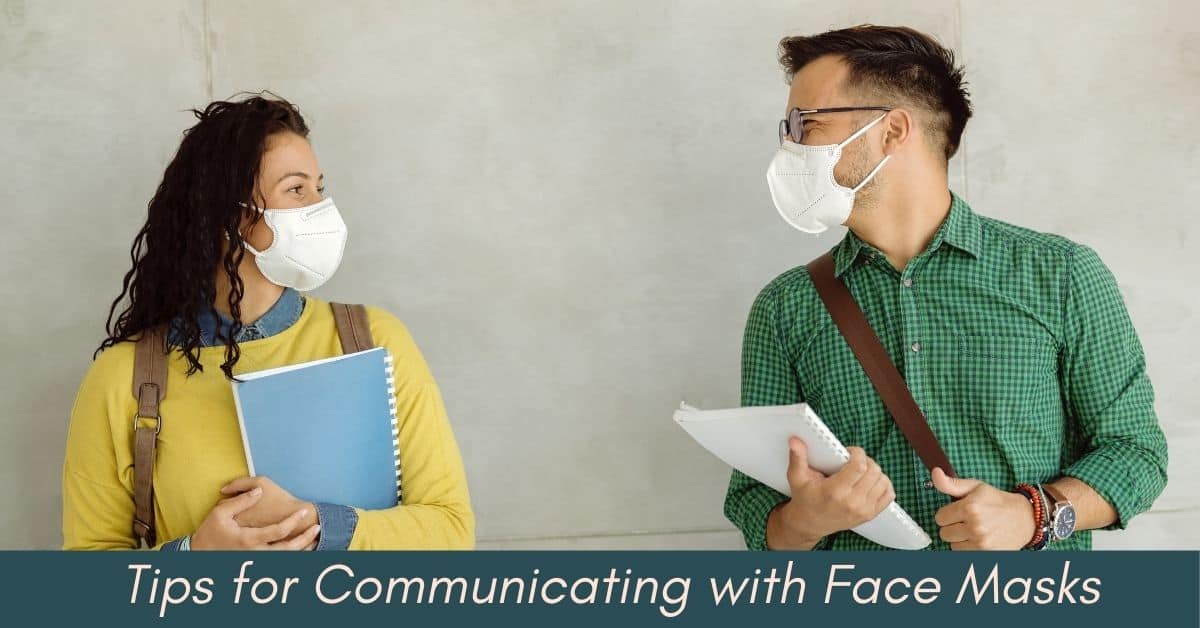This year, face masks have been recommended to curb the spread of the airborne coronavirus. That said, the use of face masks presents new challenges for people living with hearing loss. Let’s take a look at some of the challenges – and potential solutions- to communicating with face masks.
Sound Muffling
People with hearing loss already hear in a way that will often sound muted, mumbled or muffled. In this era of face masks, these hearing issues are especially emphasized as the masks dampen the sound of a voice. Higher frequency voices, especially those of children, are among the most muffled by the barrier of a mask.
Unfortunately, there isn’t a direct solution to this issue, but working around it can be easily done through texting or writing. When someone you are conversing with is having difficulty comprehending what you are saying, putting your words into writing can make communication much easier.
Lip Reading
Living with hearing loss means you have to adapt to not catching everything that is said. To help fill in the gaps many people watch the lips of the speaker to help parse what is being said. Even if someone with hearing loss doesn’t consider themselves a “lip reader” they may intuitively benefit from watching speakers as they are speaking. Watching facial expression and mouth shape can help bring into focus what is being said, even if the actual words are muffled or unintelligible because of hearing loss.
For the most part, face masks take lip reading off the table. Almost all face masks conceal the nose and mouth, making it harder to identify who is speaking and impossible to use mouth movements as clues for what is being said.
While this is a serious drawback to face masks, there are recognized solutions. Many manufacturers now offer facemasks with a clear panel in front of the mouth to facilitate lip reading. These designs are becoming more widely available as people recognize how they can passively assist those with hearing loss.
Sound Directionality
For people with hearing loss, sounds can already be difficult to parse. Part of the issue with reduced comprehension is a difficulty in detecting the direction sounds are coming from. When face masks are added to the mix, listeners can’t reaffirm the source of speech by looking for moving lips. This can make navigating a conversation very difficult. Hearing loss minimizes the distinct differences in the voices of different speakers which makes depending on sound directionality an important factor in understanding the back-and-forth nature of multi-person conversations.
While face masks make this more difficult, there are accessibility cues you can adopt to make it easier for those with hearing loss to understand when you are speaking. One way is to adopt a small indication signal whenever you begin speaking. A small gesture like a raised finger or small wave can do the work of signaling when you are getting ready to speak.
Social Distancing
Keeping social distancing is a key part of public health this year, but this maintained distance can also make hearing harder. Social distancing eliminates the possibility of speaking close to someone’s ear so they can better understand you. If social distancing makes in person conversations difficult, we recommend switching to the written word for better comprehension and safer exchange. Among friends and family, texting is a great option. For others, a piece of scratch paper or notebook can help move the conversation forward.
Accessibility Gains
While social distancing and face masks present new challenges for those with hearing loss, this year has also provided people with hearing loss with big accessibility gains. With the necessity of increased video conferencing and online workplaces, live captioning services have also seen a rise in efficiency and popularity. Online many meetings and presentations can also be recorded for later re-watching or later captioning.
Online life is also making information more easily available in multiple formats. Workshops done over video calls can also be accessed as a written .pdf file, texted instruction, or as a non-verbal how-to video for multi-faceted, accessible learning. Even as public health depends on people taking face masks and social distancing seriously, those with hearing loss can still find connections through technology.
We provide comprehensive hearing health services, including hearing aid fittings with the latest technology. If you’ve been struggling to hear, contact us to schedule an appointment! We can reconnect you with the sounds of your life in no time.

